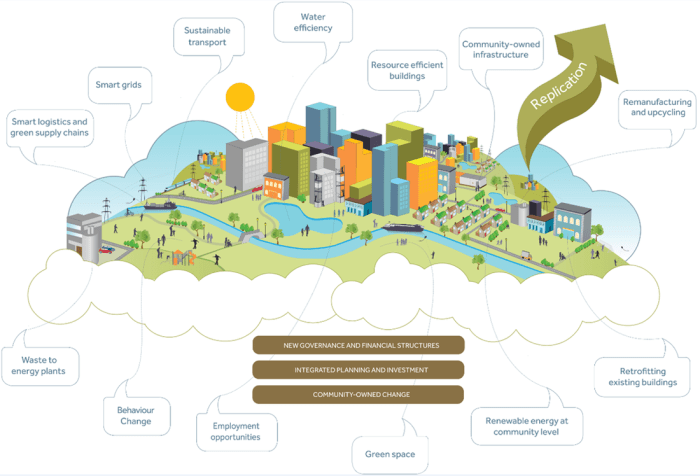
Sustainable business strategy is not just a buzzword; it’s a crucial framework for organizations aiming to thrive in today’s eco-conscious market. By embedding sustainability into their core operations, businesses can not only contribute positively to the environment but also enjoy enhanced brand loyalty and market competitiveness.
This strategy encompasses various key components such as resource management, ethical supply chains, and innovative practices that promote long-term viability. Companies like Patagonia and Unilever exemplify how dedicated sustainable practices can lead to significant operational success and customer trust.
Understanding Sustainable Business Strategy
In today’s rapidly evolving market, the concept of a sustainable business strategy has gained significant traction. It refers to a long-term approach that seeks to create value not only for shareholders but also for society and the environment. This strategy is crucial as businesses face increasing pressure to operate responsibly and transparently, addressing environmental and social issues while maintaining profitability.A sustainable business strategy integrates social, environmental, and economic considerations.
Key components that contribute to its sustainability include ethical sourcing, resource efficiency, stakeholder engagement, and innovation. Businesses that successfully implement these components can improve their brand reputation, reduce operational risks, and ensure compliance with regulations while achieving long-term growth.
Key Components of Sustainable Business Strategy
To develop a robust sustainable business strategy, companies should focus on several essential components. Understanding these elements is vital for creating a framework that balances profitability with environmental and social responsibility.
- Ethical Sourcing: Companies should prioritize sourcing materials from suppliers that adhere to ethical labor practices and sustainable resource management. For instance, Patagonia, an outdoor apparel brand, emphasizes using recycled materials and ensures fair labor conditions in its supply chain.
- Resource Efficiency: Improving resource efficiency involves minimizing waste and optimizing energy usage. Unilever has achieved substantial energy savings by implementing energy-efficient practices across its production processes, showcasing a commitment to environmental stewardship.
- Stakeholder Engagement: Engaging with stakeholders, including employees, customers, and communities, is crucial for understanding their needs and expectations. Starbucks actively seeks customer feedback to enhance sustainability initiatives, such as promoting reusable cups and responsibly sourced coffee.
- Innovation: Encouraging innovation in product development can lead to sustainable solutions. Tesla exemplifies this by producing electric vehicles that reduce reliance on fossil fuels while pushing the automotive industry towards a more sustainable future.
Examples of Companies Implementing Sustainable Business Strategies
Numerous companies have successfully integrated sustainable business strategies into their operations, setting benchmarks for others to follow. These examples highlight how sustainability can align with business objectives.
- Interface, Inc.: This carpet tile manufacturer has embraced sustainability by committing to a mission called “Mission Zero,” aiming to eliminate any negative impact on the environment by 2020. Interface utilizes recycled materials and has significantly reduced its carbon footprint through innovative manufacturing processes.
- Walmart: Walmart has made strides in sustainability by setting ambitious goals for reducing greenhouse gas emissions across its supply chain and improving energy efficiency in its stores. Their commitment to sustainability has led to cost savings and improved public perception.
- Danone: This multinational food-products corporation focuses on health and sustainability, integrating environmental concerns into its product innovations. Danone’s commitment to using sustainable packaging and promoting biodiversity reinforces its sustainable business model.
Integrating Sustainability into Branding and Business Management

Sustainability is no longer just a buzzword; it’s a vital component of modern business strategy, influencing how brands are perceived and managed. By embracing sustainable practices, companies can enhance their brand identity and reputation, appealing to a growing base of environmentally conscious consumers. This integration goes beyond mere compliance; it’s about embedding sustainability into the core of business management and branding efforts.The connection between sustainability and branding is significant, as a commitment to sustainable practices can distinguish a brand in a competitive marketplace.
Consumers today are keen on supporting brands that align with their values, particularly regarding environmental stewardship. A strong sustainable brand identity can foster customer loyalty and trust, leading to a more robust market position. For instance, Patagonia, an outdoor apparel brand, has built its identity around environmental activism, which resonates deeply with its customer base, thus boosting brand loyalty and sales.
Incorporating Sustainable Practices into Business Management
Adopting sustainable practices within business management requires a structured and strategic approach to ensure that sustainability is woven into the organizational fabric. A comprehensive plan should include the following elements:
1. Assessment of Current Practices
Conducting a thorough analysis of existing business operations helps identify areas where sustainability can be improved. This includes evaluating supply chain practices, energy usage, and waste management.
2. Setting Clear Sustainability Goals
Establishing specific, measurable, achievable, relevant, and time-bound (SMART) goals is crucial. For example, a company might aim to reduce carbon emissions by 25% within five years.
3. Employee Engagement and Training
Educating employees about sustainability initiatives is vital for successful implementation. Workshops and training sessions can empower staff to make eco-friendly choices in their daily tasks.
4. Partnerships and Collaborations
Engaging with stakeholders, including suppliers, customers, and community organizations, can enhance sustainability efforts. Collaborative projects can lead to innovative solutions and shared resources.
5. Performance Monitoring and Reporting
Regularly tracking progress against sustainability goals ensures accountability. Transparent reporting to stakeholders enhances credibility and trust.
Measuring the Effectiveness of Sustainability Initiatives in Branding
To gauge the impact of sustainability initiatives on branding, businesses should implement effective measurement strategies. These strategies can include the following methods:
Customer Surveys and Feedback
Directly gathering consumer insights through surveys can reveal how sustainability efforts influence brand perception. Positive feedback can be a significant indicator of successful branding.
Sales and Market Share Analysis
Monitoring changes in sales and market share post-implementation of sustainability initiatives can highlight the financial impact of a sustainable brand identity.
Social Media Engagement Metrics
Analyzing engagement on social media platforms can provide insights into how well sustainability messaging resonates with audiences. Increased mentions and positive sentiments can indicate successful branding.
Sustainability Reporting Standards
Utilizing frameworks such as the Global Reporting Initiative (GRI) or the Sustainability Accounting Standards Board (SASB) allows for a standardized approach to measuring sustainability impacts.By effectively integrating sustainability into branding and business management, companies can create a lasting competitive advantage while contributing positively to society and the environment.
Financial Implications of Sustainable Business Practices

Adopting a sustainable business strategy not only aligns a company with ethical and environmental standards but also presents significant financial advantages. As businesses increasingly recognize the importance of sustainability, they find that integrating eco-friendly practices can lead to cost savings, brand loyalty, and overall economic resilience. Understanding the financial implications of these practices is crucial for any organization looking to thrive in today’s market.Sustainable business practices can lead to various financial benefits, enabling organizations to achieve long-term profitability while contributing positively to the environment.
Companies that prioritize sustainability often experience reduced operational costs, improved efficiencies, and enhanced brand reputation. Here are some notable financial benefits of adopting a sustainable business strategy:
Financial Benefits of Sustainable Practices
Investing in sustainable business strategies can yield substantial financial benefits in several areas. These include, but are not limited to, the following:
- Cost Savings: Implementing energy-efficient technologies and reducing waste can decrease utility bills and operational costs significantly. For instance, companies like Walmart have reported saving millions by investing in energy-efficient systems.
- Increased Revenue: Sustainable practices can attract environmentally conscious consumers, leading to increased sales. A study by Nielsen showed that 66% of global consumers are willing to pay more for sustainable brands.
- Risk Management: Companies that adopt sustainable practices are often better positioned to manage risks associated with regulatory changes, resource scarcity, and environmental disasters. This proactive approach can save money in the long run.
- Access to Capital: Many investors are now prioritizing companies with strong sustainability credentials. Businesses with effective sustainable practices might find it easier to attract investment or secure loans.
Effective cost management is essential in pursuing sustainability goals without compromising on quality or service. Organizations can achieve cost efficiency through strategic planning and execution. Here are some strategies for managing costs while implementing sustainable practices:
Cost Management Strategies for Sustainability
Organizations can strategically manage costs as they pursue sustainability by considering the following tactics:
- Energy Audits: Conducting regular energy audits helps identify areas for improvement, enabling companies to invest in the most cost-effective energy-saving measures.
- Supplier Assessment: Working with suppliers who share sustainability goals can lead to bulk purchasing and lower costs. Partnering with sustainable suppliers can also enhance brand credibility.
- Employee Engagement: Involving employees in sustainability initiatives can foster creativity and innovation, leading to cost-saving ideas. Engaged employees are more likely to contribute to waste reduction and efficiency improvements.
- Lifecycle Cost Analysis: Analyzing the total cost of ownership for products and processes ensures that sustainability investments yield long-term savings rather than short-term expenses.
When comparing traditional business accounting practices with those that embrace sustainability, it’s important to recognize the shift in focus from merely financial outcomes to broader societal impacts. Sustainable accounting practices integrate environmental and social factors into financial decisions, providing a more comprehensive view of a company’s performance and potential.
Comparison of Traditional and Sustainable Accounting Practices
The differences between traditional accounting practices and those that incorporate sustainability are significant. These distinctions include:
- Focus on Short-term vs. Long-term: Traditional accounting often emphasizes short-term financial results, while sustainable accounting considers long-term impacts on the environment and society.
- Financial vs. Non-Financial Metrics: Traditional practices primarily use financial metrics, whereas sustainable accounting incorporates non-financial metrics, such as carbon footprint and social impact.
- Stakeholder Engagement: Sustainable accounting often involves greater engagement with stakeholders, including customers, employees, and the community, ensuring that their concerns are factored into financial decisions.
“Sustainable business practices not only promote environmental stewardship but also enhance financial performance through cost savings, risk management, and improved brand loyalty.”
Final Wrap-Up
In conclusion, adopting a sustainable business strategy is not merely a trend but a vital approach for future-proofing organizations. It allows businesses to align their operations with global sustainability goals while also realizing financial benefits and enhancing their brand image. As more companies commit to this path, the collective impact on society and the environment will be profound, paving the way for a more sustainable tomorrow.
Questions Often Asked
What is a sustainable business strategy?
A sustainable business strategy is a plan that integrates environmental, social, and economic considerations into a company’s operations to create long-term value.
Why is sustainability important in business?
Sustainability is vital for businesses as it helps mitigate risks, enhances brand reputation, and meets the growing consumer demand for responsible practices.
How can businesses measure sustainability efforts?
Businesses can measure their sustainability efforts through metrics such as carbon footprint analysis, waste reduction statistics, and social impact assessments.
What are some common challenges in implementing sustainable practices?
Challenges include resistance to change, higher upfront costs, and the complexity of supply chain management.
Can small businesses adopt sustainable practices?
Yes, small businesses can implement sustainable practices by starting with simple changes like reducing waste, sourcing locally, and using eco-friendly materials.





